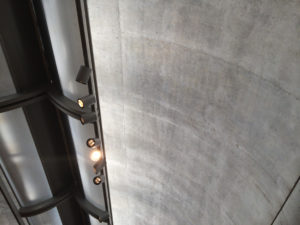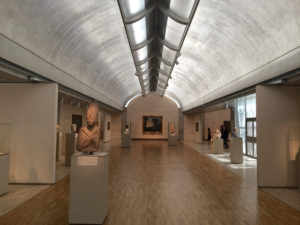Almost any use of artificial light is basically dramatic. It is beyond nature, it is man made and under his control.
~ Stanley McCandless
Mills Studio Statement
Today’s building and lighting technologies allow us to deliver light wherever, whenever, and however we desire. These desires must be channeled by artistic, scientific, and technologic considerations that determine lighting’s ultimate affects to fulfill the purposes of lighting. Architect Louis Kahn accurately believed that the primary purpose of lighting is to help humans gather information, with much of the gathering done with the human eye. Thus, it followed for Kahn, “that light is the maker of material and material is spent light.” Seeing, and thus materials, is only made possible with light. So how we use light determines if we see and what we see. As importantly, how we use light also determines if we do not see and what we do not see.
“Light and seeing are inseparable conceptions. We in fact make what we see by making things visible, and we make them appear and disappear to suit the nuances of our desires.”
Lighting Designer, Richard KellyArchitect Louis Kahn, Lighting Designer Richard Kelly, Lighting Designer and collaborator Robert Singer, and Artist James Turrell have shaped mills studio’s attitude toward the physical and spiritual qualities of light and the use of those qualities to create architecture.
Lighting can accentuate or deny the inherent qualities of both materials and spatial configurations by either enhancing or detracting from their perceptual experience. Both natural and artificial light have the ability to either reinforce or disrupt the design intent and architectural drama. In a real sense, all lighting design is theatrical.
All building lighting is the selective control and manipulation of natural phenomena, it is not natural, but manmade. What we choose to light, and equally important not light, is a way of editing the architecture and giving hierarchy to our experience. Light is also responsible for shade and shadow, so the absence of light has as much expressive power as light itself. When we choose to place an area in shade we separate it from the natural world and make it manmade. Lighting has the power to make architecture a different, yet equally dramatic experience during both the day and the night. Lighting has the power to make home, theater. Lighting has the power to make architecture living, changing, and adaptable.
“Good lighting is a vital part of good living.”
Lighting Designer, Richard KellyModern architecture has a design agenda, material pallet, and spatial intentions that provide particular lighting challenges and opportunities. The architectural agenda includes a level of abstraction that requires light to be understood and used geometrically, light as points, planes, and volumes. The material pallet of glass, steel, and concrete requires specific lighting strategies to address these material’s inherent qualities, especially reflections and transparency.
Glass has the inherent ability to both act as a reflective surface, making one light into multiple lights, and a disappearing transparent surface depending solely on how it is lit. Reflections and transparency are both a daytime and nighttime phenomenon and a consideration from outside looking in and from inside looking out. Reflectivity and transparency are achieved with different combinations of daylighting and artificial lighting, with the more daylighting a building employs the more artificial light required to mitigate glare. Lighting is the element that determines the amount of visual continuity between interior and exterior, both from the exterior and interior perspective, and during both the day and night.
Modern spatial sensibilities use additional means to walls and fixed construction to define spaces and functions. Among these other methods, lighting can be used to define spaces and functions in an ephemeral versus fixed way that helps achieve functional flexibility providing the freedom to change and adapt, and remain indeterminate. Lighting can replace fixed means to reinforce the modern sense of spatial continuity and a reciprocity of interior and exterior.
Nighttime landscape lighting should serve both functional purposes and reinforce architectural intentions, helping to define how building and site interact. Landscape lighting’s most basic purpose is to provide the necessary illumination to safely see where one is going. Of equal importance, landscape lighting provides the means to implement aspects of the architectural agenda, such as physically, visually, and metaphorically connecting or separating inside and outside. Lighting the outside at night makes glass transparent from the interior and the ambient light from exterior landscape lighting can light the interior through the transparent glass. Or a non-lighted landscape can be lit from the interior ambient light which helps make the glass reflective from the interior, but transparent from the outside.
“It is very easily possible to make the surrounding scenery the wallpaper of the home.”
Lighting Designer, Richard KellyLandscape lighting is a means for us to domesticate the exterior and make the outside an inside under human control. Landscape lighting provides the opportunity to define a distinct realm without the use of fences and walls. Because light is not contained by private property boundaries, landscape and building lighting allows us to extend our sphere of influence beyond the traditional private property boundaries. Lighting not only affects our perception of the Landscape, but the landscape can greatly affect our perception of light, especially daylight. Landscaping, plants, and ground cover can serve to filter and soften daylight or enhance the sharpness of natural light.
Light itself is the design medium, but materials, products, and technology are the means we use to shape the medium. Determining the sources for generating light, the resources used for distributing light, and the mechanisms used for controlling light all affect how we craft light to provide the intended architecture. The decision to use portable fixtures or the more modern treatment of hiding the light source follows from these architectural intentions. The decision to use incandescent or LED lighting is more than just about energy consumption, but also about color temperature and optical color representation that affect the true color of art, finishes, fabrics, and faces. We have the power to either enhance inherent qualities or manipulate these qualities to a desired effect by our lighting design choices.
Modern technology allows man to master and configure nature to human ends. Control systems are among the means providing individuals the ability to spontaneously and instantly remake their domain. Switches, mobile devices, apps, dimming, sensors, color changing, and automation all allow us to craft the look and feel of any space, as well as determine its functionality and efficiency. Control systems allow us to set and change a space’s mood – home as theater. Lighting control provides us the ability to defeat traditional daytime and nighttime limitations, and make the daytime and nighttime architectural experiences uniquely dramatic. Control systems allow us to seamlessly connect the inside and outside. Lighting control systems can integrate with other building control systems to further integrate lighting with other building aspects making a building responsive to changing natural phenomenon and human occupation.
“To the extent that Modernity entails the progressive mastery and reconfiguration of nature to human ends, whether by technological or social means, control systems are a necessary if often overlooked factor in that process.”
Sandy Isenstadt, The Invention of Modern LightMost lighting design is concerned with how light affects materials, spaces, and our ability to see. But some designers and artists treat light as something to look at itself. Light is expressed as an intangible medium and as a tangible material with its own presence. Light is used to make empty space ephemerally solid. Artist James Turrell is one of the most accomplished at contemplating the phenomena and nature of light, and how the combination of our eyes, senses, mind, and context affect our perception of light’s inherent qualities of color, volume, and transparency and opacity. Turrell creates immersive architectural environments that situate the body in space in relation to light in an intentional way that heightens our perceptions and senses and make us acutely aware of the physical aspects of seeing and the physical presence of light. Turrell uses light to express a belief that man needs to connect to both the physical natural world and simultaneously to a larger life affirming spiritual world.
“With their refined formal language and quiet, almost reverential atmospheres, his installations celebrate the optical and emotional effects of luminosity.”
Guggenheim Museum Exhibition BrochureArchitect Louis Kahn’s Kimbell Art Museum of 1966-1972, built in Fort Worth, Texas, is a case study in the proper integration of lighting and architecture. Lighting Designer Richard Kelly collaborated with Louis Kahn to integrate both natural and artificial light in a way that appears inevitable and creates an architecture impossible to imagine otherwise. Natural light from the high Texas sun enters the building from directly overhead through a narrow linear slit running parallel to the apex of a concrete vault, or more specifically a cycloid. This natural light is reflected back up onto the arched surface of the concrete vault by a linear “winged reflector” made of reflective aluminum sheet. The “winged reflector” is positioned below the skylight slit and configured and sized precisely to hide the source of the light, reflect the proper amount of light onto the concrete surface but not on the paintings, and allow the proper amount of light to pass through the reflector and reach eye level. The reflected, even ambient light gives the concrete cycloid surfaces an ethereal quality and makes the galleries near perfect for seeing artwork.


The reflector fabrication also serves as an armature to mount the fixtures providing artificial light. The reflector’s shape, reflectivity, and transparency all make it a lightweight design feature providing scale and character to the architectural space. The reflector serves purposes beyond lighting as most will only experience its lighting effects, but never realize how the reflector manipulates light and affects the architecture. Each skylight, cycloid bay, and reflector integrate to act together as a “light fixture” providing both natural and artificial light because the process that produced their resolution is also a case study. An Architect’s clear intent was interpreted by an understanding lighting designer at a point in the process where the architecture could affect the lighting design and the lighting design could affect the architecture. Intentions and intuition proposed a resolution; the resolution was mathematically confirmed with technology by computer analysis by the light fixture manufacturer Edison Price; and physical samples and mock-ups were used to distinguish minute differences only detectable by human interaction to determine the correct size of holes and relative opaque to open percentages. The Kimbell Museum’s resolution for capturing and manipulating light connects the architecture to the larger context of the environment and natural phenomena, and makes us subtly aware of the passage of time during both the day and the seasons.
“Knowledge of physics, optics, electricity, ergonomics, business, codes, environmental issues, construction, vision and the art of design, are all essential to creating great lighting solutions.”
Robert Singer AssociatesMore than other project collaborators who work to reinforce the architectural intent, the lighting designer interprets and edits the architecture. Thus, the lighting designers chief qualifications are a desire and ability to understand the architectural intent and a belief in the expressive power of lighting to make that intent manifest. The technical ability to apply techniques can be learned, but the ability to understand why, when, and where to apply those techniques is less learned and more magically innate.
Lighting Designer Statement
Robert Singer & Assoc – Basalt, Co
We eat light, drink it through our skins. With a little more exposure to light, you feel part of things physically. I like feeling the power of light and space physically because then you can order it materially. Seeing is a very sensuous act-there’s a sweet deliciousness to feeling yourself see something.
~ James Turrell

